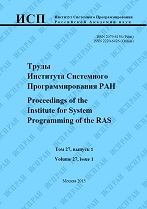|
Methods for determining the elements of the PQRST-complex of the electrocardiogram
O. A. Mashkovaab, V. V. Shakleinc, Yu. V. Markinad, E. A. Karpulevitcha, V. V. Ananevac, A. A. Asatryanae, Sh. T. Tigranyanea, S. N. Skorikad, D. Yu. Turdakovab
a Ivannikov Institute for System Programming of the RAS
b Lomonosov Moscow State University
c Yaroslav-the-Wise Novgorod State University
d Moscow Institute of Physics and Technology (National Research University)
e Russian-Armenian University
Abstract:
An electrocardiogram (ECG) is one of the most common medical examinations. High-quality interpretation of a 12-channel electrocardiogram is important for subsequent diagnosis and treatment. One of the important steps in deciphering an ECG is to determine the boundaries of the elements of the PQRST complex. The article discusses mathematical methods for determining the boundaries of the P, T waves and the QRS complex, as well as the R, P and T peaks, presents the shortcomings of mathematical methods for determining the elements of the PQRST complex. And also the values of the metrics obtained as a result of training the neural network segmentation model of the PQRST-complex are given. The experiments performed show the relevance of using neural network and combined approaches to the analysis of the PQRST complex.
Keywords:
ECG classification, convolutional neural network, PQRST complex, wavelet transform
Citation:
O. A. Mashkova, V. V. Shaklein, Yu. V. Markin, E. A. Karpulevitch, V. V. Ananev, A. A. Asatryan, Sh. T. Tigranyan, S. N. Skorik, D. Yu. Turdakov, “Methods for determining the elements of the PQRST-complex of the electrocardiogram”, Proceedings of ISP RAS, 34:4 (2022), 229–240
Linking options:
https://www.mathnet.ru/eng/tisp716 https://www.mathnet.ru/eng/tisp/v34/i4/p229
|

| Statistics & downloads: |
| Abstract page: | 45 | | Full-text PDF : | 32 |
|




 Contact us:
Contact us: Terms of Use
Terms of Use
 Registration to the website
Registration to the website Logotypes
Logotypes









 Citation in format
Citation in format 